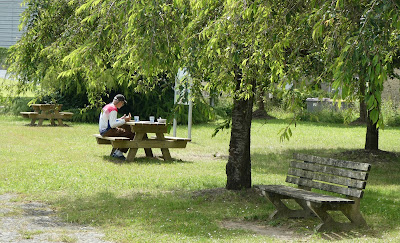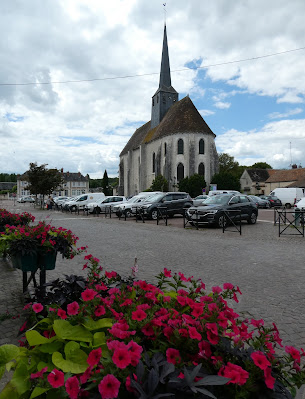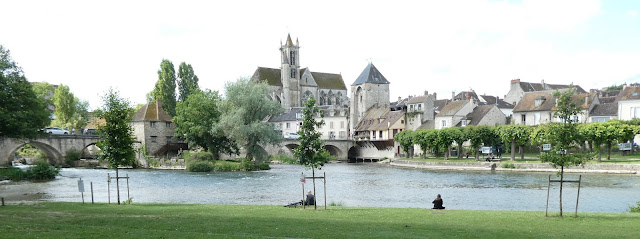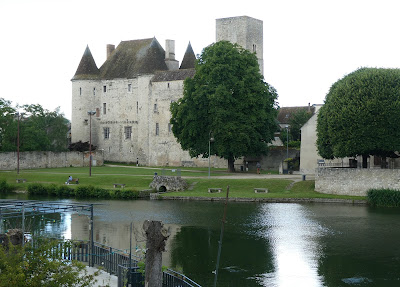Nope, nothing to do with Texas or battles with Mexico or Davy Crockett. Everything to do with the sight that greeted us shortly after 8 a.m. on Friday, June 14, as we were preparing to make an early departure from our mooring at Souppes-sur-Loing:
 |
Meet "Alamo", a 33-meter-long commercial barge, cruising past us at a whopping 3 km/hour. We didn't have to be rocket scientists to know that our hope for a seamless cruise that day and easy passage through the locks had just been smashed. In our recent days of cruising on the Canal du Loing, boat traffic had been rare--no visible boats in front or behind us while we were motoring, and only a few boats that passed us while we were moored. The problem with trailing a boat like Alamo is that they are just barely able to pass under the fixed bridges and fit into the locks, and therefore must maneuver s-l-o-w-l-y so as to minimize the "contact sport" aspect of boating. They also have a deep draft relative to many pleasure boats, and as the canals aren't nearly as deep as the rivers we've been on, this forces them to cut their cruising speed in the waterway.
We're no speed demons on C.A.R.I.B., but we can cruise more quickly and maneuver more easily in canals than one of these commercial barges. The end result for us was a day of cruising adjustments and intermittent waiting in ways small and large: Instead of departing our mooring at 8:30 a.m., we left just after 9 (and still ended up waiting for Alamo to pass through Ecluse 7, our second lock of the day); getting trapped in Ecluse 7 for 25 minutes due to a malfunctioning lock gate wasn't enough to keep us from catching up to Alamo at Ecluse 4, so we did the unusual step (for us) of stopping just downstream of the lock in order to have lunch and give Alamo the chance to put some distance between us and them; and despite cruising slowly, we still caught up with Alamo at the last three locks of our cruising day, giving us at least a 15-minute delay at each lock compared to what the passage time would have been had we been on our own.
Eight hours after casting off from Souppes, we finally, exhaustedly, moored at Montargis, at least 3 hours later than our day-before calculations had predicted. So, yes, we will "remember the Alamo" for quite some time, especially given that parking adjacent to Alamo was our best option in Montargis.
 |
| The captain on Alamo was handling the boat all on his own, so Lon gave him some assistance with loading an air conditioning unit. |
Despite the test of our patience, the cruise on the 14th was actually quite pleasant, as had been the other cruise days on the Canal du Loing.
We started our foray onto the Canal du Loing on Saturday, June 8, when we turned off the Seine River onto the short, 1-km stretch of the Loing River that took us to the medieval town of Moret-sur-Loing. Sitting at the border between the kingdom of France and Burgundy at the end of the 12th century, the town was fortified by King Philip Augustus. We spent two nights there last summer, and we didn't feel the need to re-do the official city walking tour, but it's a beautiful little place and the view of town from across the Loing River remains stunning.
 |
| The passarelle into Saint-Mammés, the Seine at top left and the Loing beneath our feet. |
 |
| The local church, in Romanesque style, is dedicated to Saint Mammes, a 3rd-century saint. It was built sometime in the 11th century. |
The Canal du Loing is one of the of four canals in the so-called "Bourbonnais Route" that will constitute a large part of our cruising itinerary this summer. Bourbonnais was a historic and cultural region in France that originated in the feudal era. At the north end, the Bourbonnais Route begins in Saint-Mammés with the Canal du Loing, then the Canal de Briare, the Canal latéral à la Loire, and finally, the Canal du Centre, ending at Chalon-sur-Saone on the Saone River. (We'll have to decide "right" or "left" when we reach the Saone.)
The Canal du Loing was created during the 1720's and runs laterally to the Loing River for most of its 49-kilometer length, with only two short sections that use the actual river. Starting as we did at the Saint-Mammés end, we would be going "up" in each of its 18 locks and then enter the Canal de Briare at the town of Montargis.
Our destination for our first day on the canal was the town of Nemours, a journey of 19 kilometers with 7 locks, and estimated to take about 4 hours.
The town has its prehistoric past, of course, but what is recorded history starts in the 11th century with the establishment of a lordship in Nemours. Along with the 12th century lordship of the second lord of Nemours, Gauthier I de Villebeon, grand chamberlain of kings Louis VII and Philippe Auguste, came the construction of a castle and a church. The city was hard-hit by a fire in 1358 during the Hundred Years War--the castle survived, although most of the church had to be rebuilt.
 |
| The castle currently houses a fine arts museum, unfortunately, it was closed the day we were in town. |
 |
| While walking around Nemours, we got our first inkling of the challenges faced by commercial barges in the Canal du Loing--it was a tight fit for "Henrietta" under the fixed bridge. |
 |
| The creation of an artificial river running through Nemours formerly allowed for the operation of mills. Now, it's just picturesque. |
The walk around Nemours didn't take too long, giving us plenty of time to pick up a few groceries and finally--finally--finish removing the winter plastic film from the boat windows. That being accomplished, we continued our cruise on Wednesday, June 12. It was a gorgeous day to be on the water, with not a cloud in the sky when we started out. Given the location of appropriate mooring spots, we only cruised 11 kilometers with 3 locks, so we were at the halte de plaisance in Souppes-sur-Loing well before lunch.
 |
| This nice park and picnic area was right outside our door. The full sun made it the smart place for Lon to have lunch. |
 |
| Quiet it may be, but it still has its 12th C. church. |
We stayed at the Souppes mooring for 2 nights because we wanted to dust the bikes off and head to the nearby medieval town of Château-Landon. Only 20 minutes and 7 kilometers put us into a different world.
In legend, Château-Landon was the site where, in the early 6th C., the monk Severinus arrived from Switzerland and miraculously healed the first Christian Frankish king Clovis. The basilica built to commemorate that miracle would later become the royal abbey of Saint-Severin. Château-Landon became a pilgrimage town, and after it became a possession of the King of France in 1068, it became a royal residence. With the support of both religious and secular powers, the city became an important religious center, which included four monasteries and priories. In the 14th C. it received a royal charter to produce woolen cloth; the remnants of mills remain along the Fusain River that flows at the base of the promontory upon which the town was built.
 |
| Some of the buildings of Château-Landon loom over one of the historic mills on the Fusain. |
 |
| The church of the Saint-Severin Abbey. The abbey is now a nursing home, with only the gardens open to the public on any routine basis. |
 |
| A bit of whimsy. |
 |
| The 10th C. Saint-Thugal tower, the only remaining part of the basilica of that name. |
 |
| Notre Dame of the Assumption Church 10th - 14th centuries. |
 |
| As with any self-respecting fortified town, it was built "up high". |
 |
| The southern entrance through the ramparts had a few stairs to try out. |
 |
| The north face of the medieval defensive tower and walls, present despite the best efforts of 17th C construction to erase it. |
 |
| Tour Saint-Andre, a 12 C. vestige of an important Cluniac abbey. It rests on private property, but the owners leave their driveway gate open to allow passersby to view it from afar. |
After all that walking through history we deserved a modern-day break. Fortunately, Le Cheval Blanc restaurant was open and was up to the task.
 |
| I don't often take pictures of food, but my chicken with a cauliflower gratin was the plat du jour and was delicious. |
 |
| A relaxed Lon at the popular lunchtime dining spot. |
Our departure and cruise on the following day, June 14, has already been discussed in detail. Suffice it to say that it was a good feeling at the end of that day to leave the Canal du Loing and enter the Canal de Briare. And it was an even better feeling to moor in Montargis, even though the less-than-optimal location on the quay meant that Lon had to expend his remaining stores of energy to pound mooring stakes.







Your chicken with cauliflower augratin looks SCRUMPTIOUS ! You guys look GREAT !
ReplyDelete